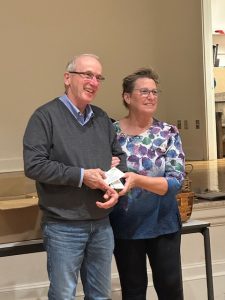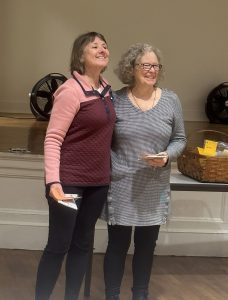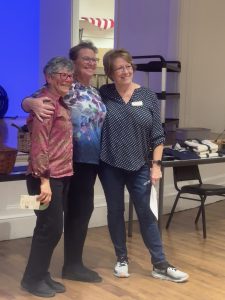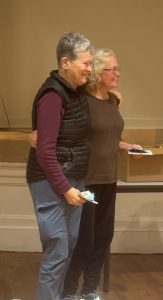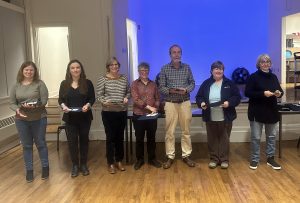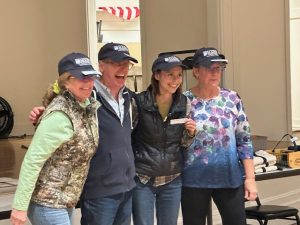Master Gardener Volunteers Newsletter-Hancock County – December 2023
Table of Contents
HEAR FROM YOU! / MG RECOGNITION / NATIVE SEEDS / PROBLEM WITH PEAT
Upcoming Dates to Remember!
Dec 25 – Extension Office Closed – HOLIDAY
Dec 31 – Deadline for Project Renewal online form
Dec 31 – Deadline for local MGV Survey (read below)
Jan 1 – Extension Office Closed – HOLIDAY
MGVs, past and present, we want to hear from you!
REMINDER: Please take a few minutes and complete the survey that was sent out last month. It means a lot to us and will help us to plan how best to support you and keep you engaged. GOOGLE FORM
MG Volunteers who are leading projects may have received an email from Becky Gray this week prompting folks to complete the 2024 MGV Project Enrollment form online. This online form will be used statewide, including Hancock County to determine our projects for the coming year. The deadline for completing this form is December 31, 2023.
Master Gardener Volunteers Recognition Event
by Mary Doherty, MGV
Master Gardener Volunteers gathered on November 16, 2023, to celebrate all the Volunteers who make up the Hancock/Washington County Extension Program. They provide food and flowers to enhance the Counties they serve.
Members of the MG Advisory Committee were recognized for their contributions to lead our Master Gardener Volunteers throughout the 2022-2023 season. Zabet NeuCollins and Rachel Emus were recognized for their contributions as Co-Chairs for the 2022-2023 season. Jane Ham and John McClellan will provide leadership for the MG Advisory Committee in the upcoming 2023-2024 season. A card to Rita Buddemeyer was passed around and signed to wish her well in her new home and thank her for her many years of service; she has moved to Penobscot County and those of us who know her will miss her.
Sue Baez along with the help of Marjorie Peronto presented yearly lapel pins, hats, shirts, and sweatshirts to acknowledge the many volunteer hours that help make MGV a Program we can all be proud of.
After a delicious buffet was enjoyed by the volunteers, Lisa DePasquale and Patty Perrson led us in Gardening Bingo fun. It was a great opportunity to see fellow gardeners and meet new ones. Sue presented a slide show highlighting different projects throughout the two counties.
Sue noted that she made an untimely mistake at the Recognition event and skipped a whole year of Lapel Pin awardees. She somehow skipped right over Year 12 – Jan McIntyre, David Struck, and Gaylord Sundt!
Many apologies to these 3 wonderful MGV’s!
Thank you to the members of the Advisory Committee who helped Sue organize and set up this event.
Native Seed Sowing – in Winter!
by Betsy Adams, MGVA
Did you know that you can, and should, sow native wildflower seeds in the Winter? Many native seeds require an extended cold and moist period to germinate. This is known as winter seed stratification. The idea is to mimic the seeds’ natural environment so that they can break dormancy and germinate in the Spring.
Seeds can be sown from late October to early February and left unprotected from the cold, rain, and snow; so it’s not too late! Not all species require winter stratification (milkweed, for example) but they can still be sown at this time and you may find enhanced germination after a winter outdoors. Unlike cultivated plants and vegetables, germination of native seeds improves with the fluctuating temperatures of our Maine winters.
Growing native plants from seeds is the best way to ensure genetic diversity. Plant health is also a benefit of winter seed sowing; damping off, fungal gnats, aphids, and algae growth, the bane of greenhouse sowing, are nearly non-existent with outdoor sowing.
Seeds can be sown in pots or seed flats that are tucked out of the way in a shady location. Under a bench or deck works as long as they can still get the benefit of rain and snow. Clay pots are great because they’re porous; but if you’ve saved 4” plastic pots or seed trays, or even larger pots, from the nursery, those will work fine. You will find lots of recipes for the makeup of the seed starting mix. You can use a premade soil-less seed starting mix, or you can try a mix of 2/3 compost or potting soil and 1/3 perlite to ensure good drainage. You can plant the seeds more thickly than you may be accustomed to – ¼” to 1/8” apart depending on their size.
After sowing the seeds according to each species depth requirement, cover with coarse sand rather than potting soil. The sharp grit of the sand keeps the rain from splashing the seeds out and creates a dry surface that prevents rot. Different seeds need to be covered in different amounts – one rule of thumb suggested by many growers is to sow the seeds as deep as they are thick. Very small seeds are barely covered, if at all. Plant only one species per pot, and don’t forget to label them! Water gently until thoroughly damp, but not soggy and place in a relatively shady spot. Put all the pots close to each other and cover with hardware cloth, weighted down with heavy rocks or wood in the corners, to keep the critters away. Then leave them alone and wait til Spring! Check the pots if we have a very dry winter. You might need to do a little additional gentle watering.
See https://extension.umaine.edu/gardening/2016/08/01/maine-home-garden-news-august-2016/#article-1 and https://wildseedproject.net/2016/11/ideal-time-for-sowing-native-seeds/ for comprehensive information on sowing natives.
More on the Problems with Peat – And Some Alternatives
by Wendy Lessard, MGV
Tom Witwicki was a member of the 2017 Cumberland County MGV Training Class. He and
his wife have been avid gardeners for 50 years. After retiring from an IT career, he wanted to connect more with the gardening community, learn more about horticulture techniques and give back through volunteer work, so the MGV Program was a good fit. He credits gardening as the source of good mental, physical, and spiritual health.
Tom first became aware of the problems with using Peat through watching the BBC program “Gardeners’ World.” Every week, the host, Monty Don, spoke about using a “peat free” compost (potting mix on this side of the pond). He brought up the issue with his MGV Board; they launched a committee to investigate further and come up with an action plan.
There are three categories for why we should avoid Peat: sustainability, ecology, and impact on climate change. Let’s address them in order.
i. Sustainability. The harvesting of Peat is not a sustainable process. Peat formation
occurs extremely slowly, accumulating less than 1 cm per year. The Peat being mined
today started to lay down deposits at the end of the last Ice Age.
ii. Ecology. Peat bogs are a very special, nutrient-poor anaerobic environment supporting unique plants such as the Venus Flytrap which are found nowhere else. The strip mining process to extract Peat destroys this ecology.
iii. Climate Change. Worldwide, Peat lands hold 30% of the land-based sequestered carbon. Once harvested, peat decays and the carbon combines with Oxygen to form CO2, a major contributor to climate change. 6% of global CO2 emissions come from decaying Peat. Each year the U.S uses 1.4 million metric tons of Peat, mostly imported from Canada. Using 1 cu. Ft. of Peat is the equivalent of burning 11 lbs. of coal. The remaining Peat in the world should be left in the ground to continue its carbon sequestration role.
The good news is that the horticultural trade is developing alternatives to Peat; they’re much more available than they were just 2 years ago. Most alternative products today are based on Coir, which is the fibrous waste product of the Coconut industry. Is Coir the ideal replacement for Peat? No – it has its own carbon footprint issues due to transportation and also requires a lot of water to process out the natural salts in the plant. It doesn’t have a carbon sequestration issue, though, and on balance today is preferable to Peat. There are other Peat alternatives being developed today that aren’t Coir based, but these are not yet available at retail.
Peat in gardening can seem widespread, and here are some of Tom’s suggestions for going
Peat-free, looking at some of the use cases:
- Soil Amendment – just use compost – it’s better for the soil than Peat or other
alternatives - Microgreens growing medium – Tom uses a mix containing only rehydrated
Coir with very good “grow” results (more on hydration in a minute). - Potting Mix – For pots or raised beds. The formula Tom’s used with success is a
70% Coir, 30% Perlite mix combined with an equal amount of screened compost.
You can purchase commercial products or try making your potting mix with this formula by starting with compressed Coir and adding Perlite. These compressed coir blocks are more economical than buying a ready-to-use mix. They can be purchased at garden supply or building centers. I buy 11 lb. blocks. The coir needs to be rehydrated by adding water to the block in a large container or wheelbarrow until the coir is damp but not saturated. This route isn’t for everyone but has the advantage of cost and also pre-hydrates the coir before planting.
4. Seed Starting – To be truthful, Tom has had the most issues finding a good substitute for Pro-Mix, the standard for Peat-based seed starting. The issue seems to be the fineness of the coir especially for smaller seeds. He’s experimented with putting the coir and compost through a fine ¼” screen and this has improved his success rate. The surface of a coir-based mix will dry out faster than Peat, however, so some watering vigilance is needed.
Sadly, peat-free growing has not yet found its way into the retail world of potted plants. This is where the reader can their part in raising awareness with the local plant nurseries and creating a demand for peat-free alternatives.
Please put “The Problem with Peat” into your calendars on March 21, 2024, so you don’t miss Tom’s Zoom presentation. He will cover this topic in even more depth and it’s available statewide to MGVs and non-MGVs alike. Keep an eye out for the invitation and forward it to your gardening friends.
DO YOU KNOW
-Someone who inspires your gardening?
-Someone who is making a difference environmentally, food security, climate change mitigation – whether quietly
or loudly in one small plot or a large project?
IF SO
– We want to know, here is one way to tell us
MGVnewsletterinput@gmail.com
Our MGV newsletter is for and about Washington/Hancock MGV people, projects, and the community. MGVnewsletterinput@gmail.com, was established as a way for readers to recommend interesting topics or people for future articles, provide comments, or ask questions. It has been a little used resource, but for some of you, it has been a way to not only give input to the newsletter committee but also to make suggestions for Continuing Education and MGV projects. Try it!
This month’s newsletter sent by Sue includes articles from our new “Communicate with MGV’s” task force. We’d like the next edition to feature your suggestions and articles about gardeners and gardens. MGV’s, please contact us at MGVnewsletterinput@gmail.com with your ideas.
Thank you from
Betsy Adams, Jan M., Jane, Wendy, Linda, Mary D., Mary H., and Rita

